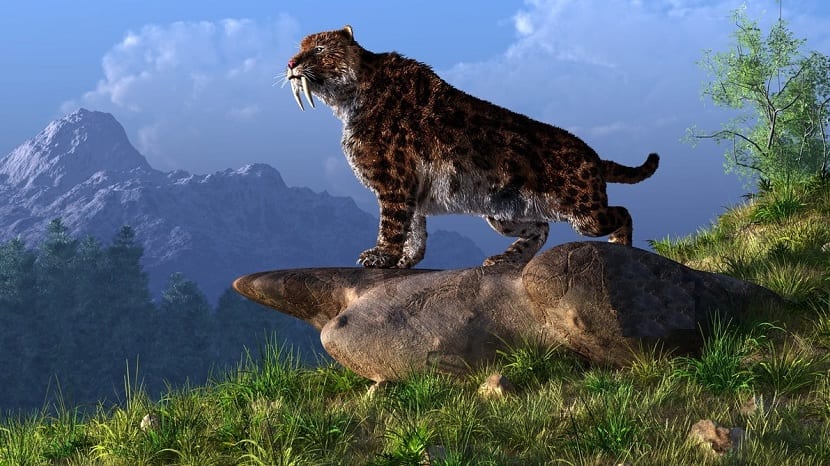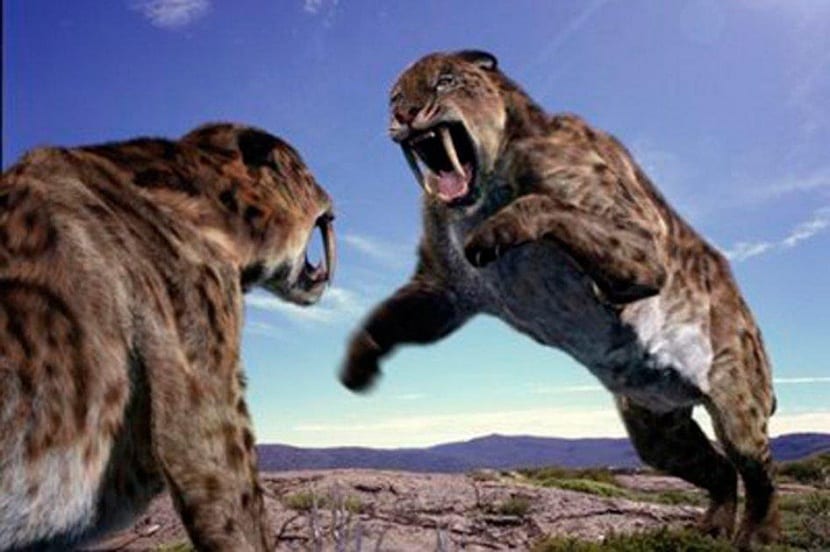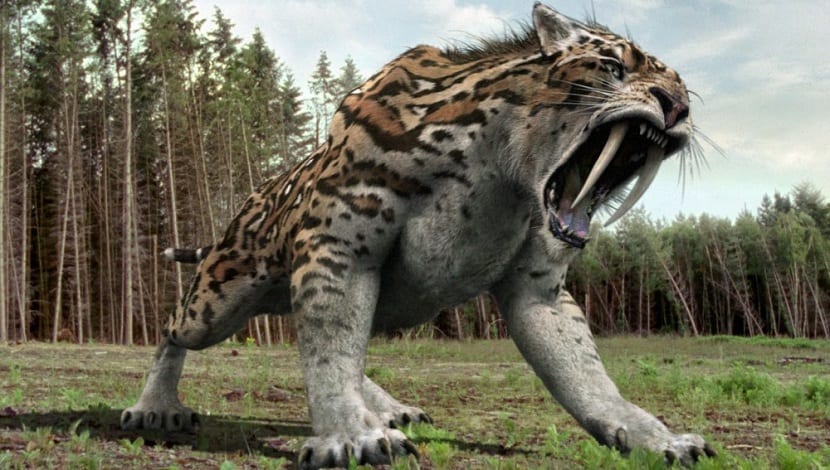
Surely you have heard of the famous Saber-toothed tiger. It is a species that is extinct today. When we talk about the famous saber tooth, it reminds us of Diego, the tiger from Ice Age. These animals existed in their time and they unravel incredible secrets. For this reason, we are going to dedicate this article to knowing what life was like for these animals and what their characteristics were. What was the cause of its extinction?
In this post we are going to cover everything you need to know about the saber-toothed tiger.
Saber-toothed tiger and its characteristics

What is used as saber teeth is a term that refers to different species of mammals that are characterized by having large canine teeth. These teeth stick out on both sides of the mouth. Animals with these characteristics lived during the Cenozoic.
Despite the name they have been given, they are not at all related to the tigers we know today. However, they were compared to them due to their large size. Saber teeth belong to the Machairodontinae subfamily, while the tigers we know today are in the Felinae subfamily. This subfamily includes many extinct genera, among which is the genus Smilodon. This genus is the one with the well-known saber-toothed tiger.
The name has been given by the curved and elongated shape of the fangs of a true saber. This genus includes all the animals with the largest canines that have been found in all history. Canines that have sometimes been 20-26 cm long. Canines have been recorded in both males and females, so it is not something distinctive in the dry of the species.
Fossils and discoveries
It is thanks to the fossil records that it can be determined that the saber teeth had a wide area of distribution throughout the American continent. They were estimated to be between 1 and 1,1 meters tall. Some specimens could reach up to 300 kg in weight, which made them really scary.
Felines use their fangs to kill prey by suffocation. They bite their throat or snout so that air cannot pass into their lungs. On some occasions, the bite is given on the head or neck in order to break the skull or vertebrae and kill them instantly. This is less frequent, since saber teeth were vulnerable to breaking if they were used to bite into bone tissue. Therefore, these animals specialized in hunting large prey, where there was less risk of biting bones. If they hunted small species, the probability of breaking their strong teeth was higher.
It is strange to think that, despite attacking large prey, the saber teeth were very powerful. And it is that, the effectiveness of these fangs resided in the angle that they could reach when opening the jaw. While the lion we know today can only open its jaw at 65 degrees, the saber-toothed tiger was capable of reaching 120 degrees.
Saber Tooth Tiger Hunting Mode

Unlike what happens with felines, the macairodontins did not want to kill their prey by suffocation. Thinking of the energy cost that having to catch the prey, keep it immobilized and bite it until it suffocates, is something extremely something for this type of animal with so much weight. Therefore, the most widespread theory that there is about the method of hunting these animals before large prey is that it attacked them from below to catch, bite and cut the throat. In this way, the prey would bleed out in a matter of minutes without being able to do anything to escape or flee.
The long, sharp, curved fangs They were in charge of penetrating the victim until they were completely neutralized and to do so more quickly than by suffocation. Some of the specimens had the edges of the tusks like a saw. In this way, they could get to make the bites with cleaner and faster cuts. Thus, they reduce the energy expenditure produced by hunting a prey and the possible risks that the prey could counterattack (in the case of some animals such as the horse kicking or the deer with the goring).
What stands out the most of these animals are the canines. The function of tearing and ending the prey is increased when it is held and immobilized on the ground. On the other hand, it is believed that, in addition to blocking respiratory flow, these canines also cut the main blood vessels that are responsible for conducting blood to the brain. When the blood no longer reaches the brain, the prey inevitably loses consciousness before dying. This avoids any situation in which it can be defended.
In the event that the prey escapes before it is able to immobilize it, it would end up completely bled out due to the bite in the throat. The consequence is that the hunting success probability of the saber-toothed tiger was very high. If this was so, why was it extinct? Let's see it now
The cause of extinction
These animals became extinct 12.000-10.000 years ago. The main cause of the disappearance of these predators was the drastic changes that occurred at the level of climate and environmental changes. These changes generated different impacts on the saber tooth food chain. The distribution of the large prey that it used to capture became much more dispersed. This made not only the search task extremely difficult, but the hunt itself.
Climate changes also caused the retreat of glaciers and increased rainfall. As ecosystems altered, so did their way of life. Changes in temperature and vegetation made it difficult to stalk prey. The competition between carnivores became extremely violent. By last, it is possible that the arrival of the first hominids accelerated their extinction by hunting.
I hope that with this information you can learn more about the saber-toothed tiger.

